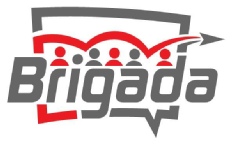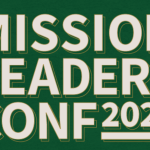I’m guessing I’m not the only one trying to make the jump from paper-based reporting over to these new HTML-based email reports (MailChimp, iContact, ConstantContact, etc.). Is there an easier way? Back when I did paper-based reports, I could print to a PDF, then send an email with the PDF attachment. Life was good. Except then I started reading about how few people open up all those attached PDF’s. I saw all kinds of advice to switch to a straight email-based (HTML) solution. But now, how do I send a paper-based report to the people who still use old-fashioned postal-service snail-mail? I print the native email-based report, using the “Printer format” feature in iContact, but I have to confess, it’s downright ugly. Is there any better way of doing this? Do we have to construct two native versions (no time for that). Ideas??? Your solution??? Please use the Comment box below the online version of Brigada (constructed in native web format, as opposed to the native email format for those preferring the email version).
11 Comments
Leave a reply Cancel reply
Subscribe to the Email Edition
The Latest Edition
Recent Comments
- ANDREW DIPROSE 2025/07/26
- Vicki 2025/07/25
- John siewert 2025/07/25
- Neal Pirolo 2025/07/25
- Roland Muller 2025/07/25
- Jon Byler 2025/07/25
- Tim 2025/07/25
- Henry Vermont 2025/07/24
- Dave Hudson 2025/07/23
- zbigniew 2025/07/23












Hey Doug, I continue to use Constant Contact for Missions Catalyst – a daughter of Brigada Today :-) for the sake of the feedback it provides on click/open rates and the ease of subscribing / unsubscribing. The mail services you mention all provide that, though each one has pros and cons with its other features – for now I’d rather stick with Constant Contact rather than mastering another, since price differences are negligible when your lists are in the thousands (e.g., can’t graceful manage them on your own or with something that’s free).
For my own newsletters, though, I borrowed a free email template from a friend and started tweaking. It’s based on tables, so it didn’t take long before I realized I could paste the template into a Word doc, do my writing/editing there (including adding/deleting cells, rows, or columns, and then print-merge the emails. No blind carbon copying or attachments involved. I just let the system create 400+ attractive emails that easily scale for screen size.The print version still requires some tweaking to make it truly paper-friendly but not very much.
Where’s the “Like” button. :-)
I realized several years back that I needed to switch to email updates for our ministry partners and friends and that it needed 1) to be as personal as possible and 2) that it could be read immediately upon opening the email without having to open an attachment. This was before Mailchimp was so popular…
I use MS Outlook for all my email and have my database there. I compose the email in Outlook, insert a photo or 2 (sometimes more) and wrap the text around it.
I don’t call it “Sherman Newsletter December 2012” or anything that resembles it’s a newsletter or update. That usually guarantees that people will decide to open it later when “they have more time to read it”, which often means much later. I use a unique subject line each time, like “God in Kyrgyzstan”, “The world in a classroom…”, “Immediate need for prayer…” so it looks like a personal email.
I make groups in Outlook and send it that way to 99 people per group.
I use color and bolding to highlight important things, and keep it as short as possible so it can be read quickly. I use hotlinks for those who want more info. In my email signature I have a link to our blog with more info.
I take the body of the email and put it in Word as a one page letter, convert it to PDF and attach it to the email. Those who want to print it can, those who don’t care don’t even need to open it. I have some older supporters who need it printed and have a friend at church who prints it out when she gets it and she hands it to the older ladies at church.
I’m taking an online course to learn how to use Word to the max and want to learn how to mail merge to personalize those emails even more. I often get quick replies from people saying they are praying and responding to something I’ve asked or said in the update.
But I also have looked into MailChimp and still want to use it in some way. I’m looking forward to other replies so I can learn better ways to communicate!
Terry, sounds like you are well ahead of the norm! Good job!
Our process is similar. We sill have a few supporters who don’t have email addresses, so I design a paper newsletter as I have always done. Then, designing the email newsletter is as simple as copying and pasting the content into Constant Contact. We include a link to the PDF file in the email for any who wish to see the newsletter in that format, or print it for posting somewhere, and Constant Contact tells me that quite few do download it.
Interestingly enough, we recently asked our supporters if they would mind receiving emailed receipts instead of a paper receipt in the mail. Every single one of them said they wouldn’t mind an email receipt, and some even hinted that “it was about time!”
I am starting to wonder if we have clung to paper newsletters for too long. They are certainly more expensive, and much more work for our forwarding agents.
100% Agreement, Brian!
Interestingly, I do my newsletter in reverse. I make the paper/print version first and save it as a pdf and each page as a jpeg and then drop the jpegs into the email template and offer the pdf as an optional download. I use mail chimp for the email distribution.
I don’t know a ton about the security side of it, but was told that it is much harder to search a jpeg for text than simply scanning text from an email. This could be an important feature.
If you want to hot link anything for your email readers, you can simply hot link the jpegs or add links above or below. All clicks are tracked and I’ve had success both hot linking the jpegs and adding additional important links below.
As for printing the paper version, my forwarding agent takes the pdf download from the email distribution and is able to begin printing the paper newsletters without me having to send him a separate email request.
Sounds like a great system, AH!
I do it similarly to Brian above. I compose my newsletter as a .pdf file first, and then have all the text and pictures in hand to copy and paste into Elite Email (the service like MailChimp that we use).
I don’t like the fact that I can’t just hit reply to send a note back to the folks sending out the newsletter. The old way with an attachment worked better for me. I still do it the old fashioned way and am probably not getting the readership I need but I’m a ludite.
Someone asked about this today. I wrote, “For the postal mail version, I’ll admit — it’s not pretty. The way I do it, so far, is I now prepare the report in the email client (iContact in my case; it might be MailChimp for you). Then I use the client to send a “test” version of the email back to my own address. It often includes a link to “show this email in your web-browser,” meant for use if the email client doesn’t do a good job displaying the email version. Then I print that web version to a PDF engine — like Adobe Acrobat Standard (about $150?) or, in my case, NitroPDF Pro. So I’m creating a PDF version that is more organized than simply printing the email (as you discovered). Then, (this is really convoluted) NitroPDF Pro has a wizard to import the PDF over to Microsoft Word. In Word, I remove all the weird PDF marks — like page numbers and “Facebook icons” and website URL addresses. By the time I’m done, the Word version actually looks fairly clean and well-formatted. Margins are a bit wider than usual, so it’s not as “efficient” in pagination as I would have liked, but otherwise, it’s actually not bad.
That’s the only way I’ve been able to figure it out so far. Let me know if you think of a better way!!!
Doug